NRSG355: Clinical Integration: Module Summaries and Analysis Report
VerifiedAdded on 2022/11/23
|13
|3360
|300
Report
AI Summary
This report provides a comprehensive overview of four key modules related to clinical integration and professional practice in nursing. Module 1 focuses on critical thinking, decision-making, and professional development, emphasizing the importance of prioritizing nursing care in emergency situations and the roles of different healthcare professionals. Module 2 explores collaborative and therapeutic practices, identifying factors that determine healthcare team composition and leadership, with a strong emphasis on patient-centered care. Module 3 delves into the provision and coordination of care, including essential questions to ask nurses and comprehensive patient assessments. Finally, Module 4 addresses professional practice, time management, delegation, and the scope of practice, including staff allocation strategies. The report analyzes various scenarios and provides recommendations based on relevant literature and best practices, aiming to enhance the understanding of clinical integration and professional development in the nursing field. The report incorporates APA formatted references to support the ideas and findings. The provided assignment is a student's work, which is available on Desklib, a platform that offers AI-based study tools.
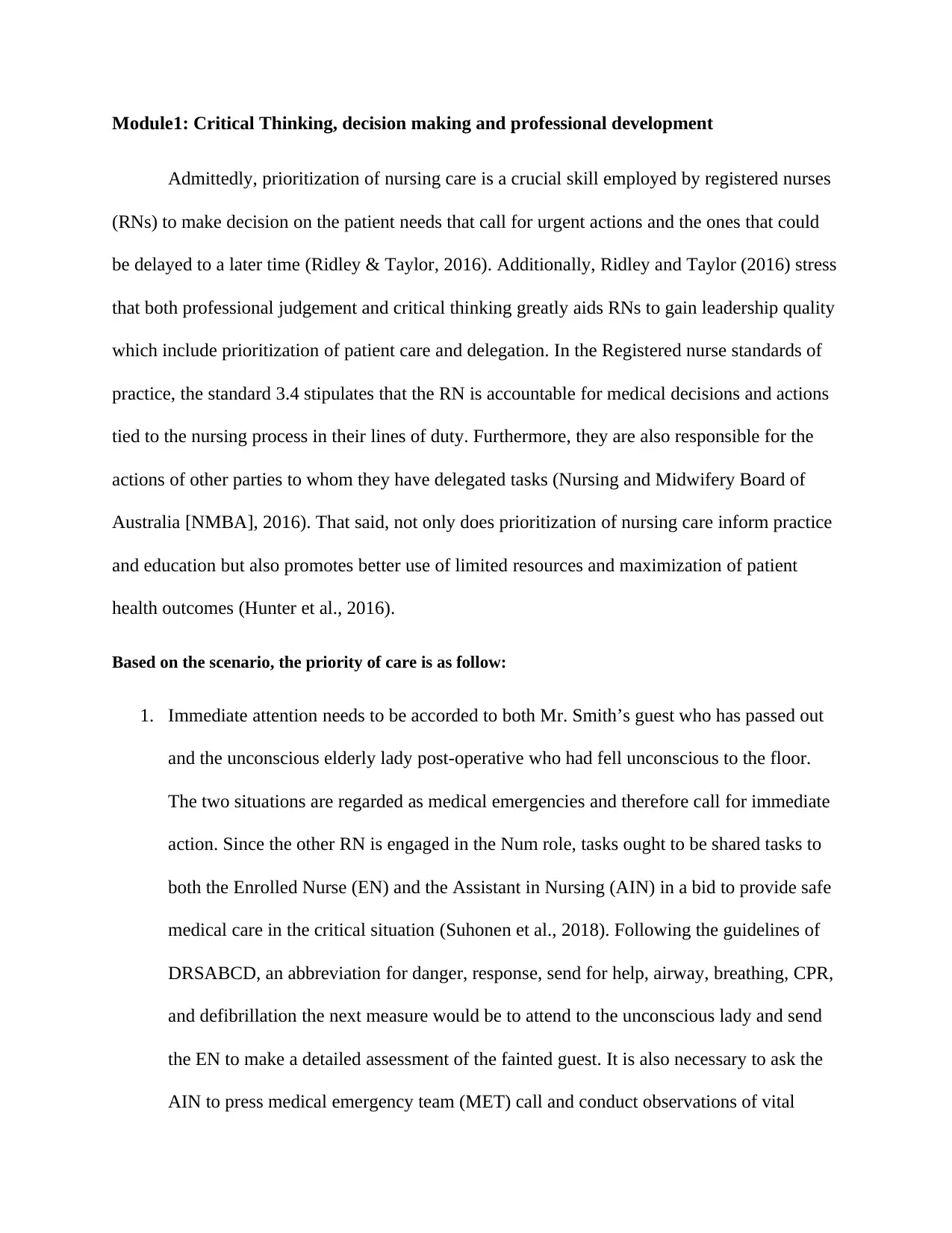
Module1: Critical Thinking, decision making and professional development
Admittedly, prioritization of nursing care is a crucial skill employed by registered nurses
(RNs) to make decision on the patient needs that call for urgent actions and the ones that could
be delayed to a later time (Ridley & Taylor, 2016). Additionally, Ridley and Taylor (2016) stress
that both professional judgement and critical thinking greatly aids RNs to gain leadership quality
which include prioritization of patient care and delegation. In the Registered nurse standards of
practice, the standard 3.4 stipulates that the RN is accountable for medical decisions and actions
tied to the nursing process in their lines of duty. Furthermore, they are also responsible for the
actions of other parties to whom they have delegated tasks (Nursing and Midwifery Board of
Australia [NMBA], 2016). That said, not only does prioritization of nursing care inform practice
and education but also promotes better use of limited resources and maximization of patient
health outcomes (Hunter et al., 2016).
Based on the scenario, the priority of care is as follow:
1. Immediate attention needs to be accorded to both Mr. Smith’s guest who has passed out
and the unconscious elderly lady post-operative who had fell unconscious to the floor.
The two situations are regarded as medical emergencies and therefore call for immediate
action. Since the other RN is engaged in the Num role, tasks ought to be shared tasks to
both the Enrolled Nurse (EN) and the Assistant in Nursing (AIN) in a bid to provide safe
medical care in the critical situation (Suhonen et al., 2018). Following the guidelines of
DRSABCD, an abbreviation for danger, response, send for help, airway, breathing, CPR,
and defibrillation the next measure would be to attend to the unconscious lady and send
the EN to make a detailed assessment of the fainted guest. It is also necessary to ask the
AIN to press medical emergency team (MET) call and conduct observations of vital
Admittedly, prioritization of nursing care is a crucial skill employed by registered nurses
(RNs) to make decision on the patient needs that call for urgent actions and the ones that could
be delayed to a later time (Ridley & Taylor, 2016). Additionally, Ridley and Taylor (2016) stress
that both professional judgement and critical thinking greatly aids RNs to gain leadership quality
which include prioritization of patient care and delegation. In the Registered nurse standards of
practice, the standard 3.4 stipulates that the RN is accountable for medical decisions and actions
tied to the nursing process in their lines of duty. Furthermore, they are also responsible for the
actions of other parties to whom they have delegated tasks (Nursing and Midwifery Board of
Australia [NMBA], 2016). That said, not only does prioritization of nursing care inform practice
and education but also promotes better use of limited resources and maximization of patient
health outcomes (Hunter et al., 2016).
Based on the scenario, the priority of care is as follow:
1. Immediate attention needs to be accorded to both Mr. Smith’s guest who has passed out
and the unconscious elderly lady post-operative who had fell unconscious to the floor.
The two situations are regarded as medical emergencies and therefore call for immediate
action. Since the other RN is engaged in the Num role, tasks ought to be shared tasks to
both the Enrolled Nurse (EN) and the Assistant in Nursing (AIN) in a bid to provide safe
medical care in the critical situation (Suhonen et al., 2018). Following the guidelines of
DRSABCD, an abbreviation for danger, response, send for help, airway, breathing, CPR,
and defibrillation the next measure would be to attend to the unconscious lady and send
the EN to make a detailed assessment of the fainted guest. It is also necessary to ask the
AIN to press medical emergency team (MET) call and conduct observations of vital
Paraphrase This Document
Need a fresh take? Get an instant paraphrase of this document with our AI Paraphraser
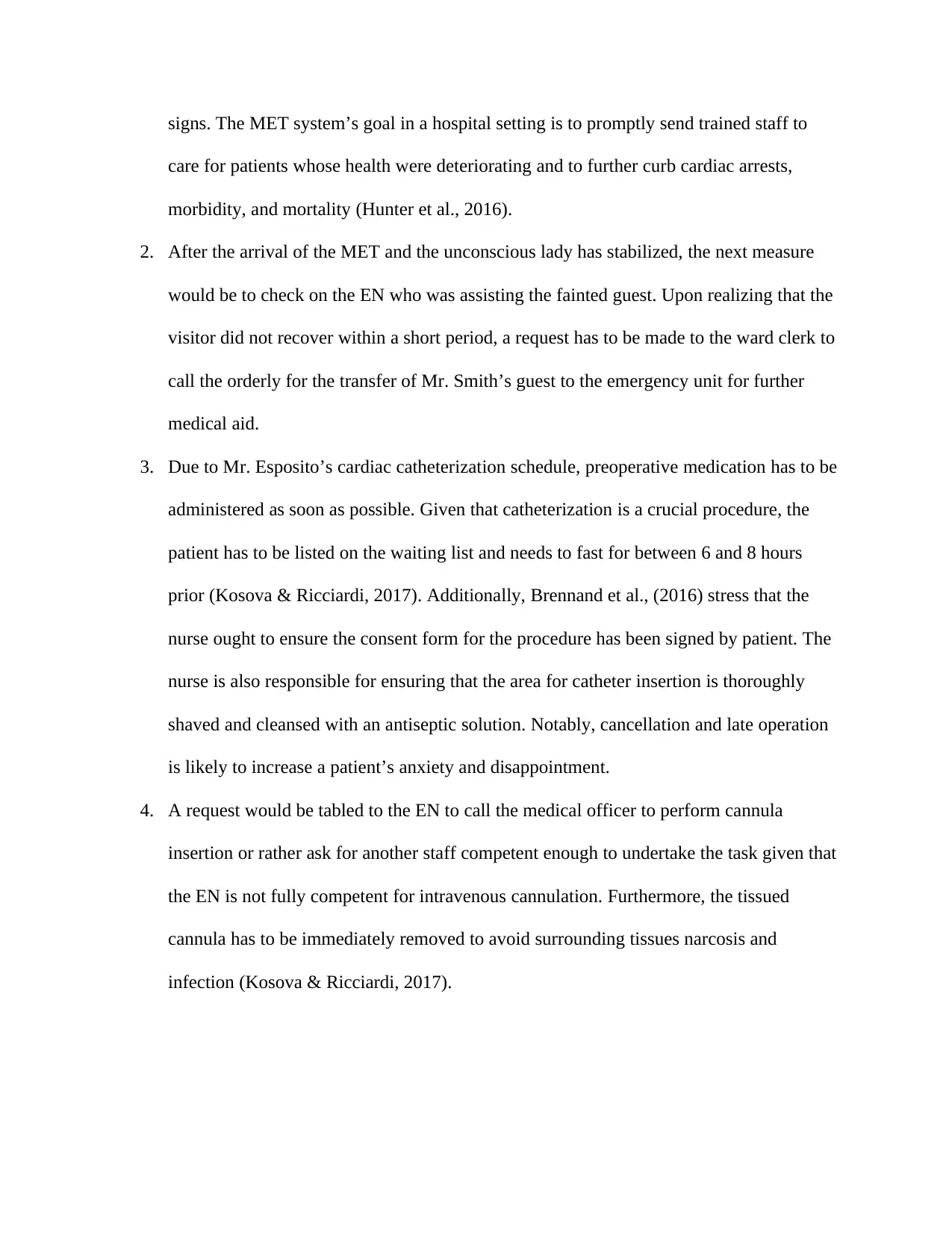
signs. The MET system’s goal in a hospital setting is to promptly send trained staff to
care for patients whose health were deteriorating and to further curb cardiac arrests,
morbidity, and mortality (Hunter et al., 2016).
2. After the arrival of the MET and the unconscious lady has stabilized, the next measure
would be to check on the EN who was assisting the fainted guest. Upon realizing that the
visitor did not recover within a short period, a request has to be made to the ward clerk to
call the orderly for the transfer of Mr. Smith’s guest to the emergency unit for further
medical aid.
3. Due to Mr. Esposito’s cardiac catheterization schedule, preoperative medication has to be
administered as soon as possible. Given that catheterization is a crucial procedure, the
patient has to be listed on the waiting list and needs to fast for between 6 and 8 hours
prior (Kosova & Ricciardi, 2017). Additionally, Brennand et al., (2016) stress that the
nurse ought to ensure the consent form for the procedure has been signed by patient. The
nurse is also responsible for ensuring that the area for catheter insertion is thoroughly
shaved and cleansed with an antiseptic solution. Notably, cancellation and late operation
is likely to increase a patient’s anxiety and disappointment.
4. A request would be tabled to the EN to call the medical officer to perform cannula
insertion or rather ask for another staff competent enough to undertake the task given that
the EN is not fully competent for intravenous cannulation. Furthermore, the tissued
cannula has to be immediately removed to avoid surrounding tissues narcosis and
infection (Kosova & Ricciardi, 2017).
care for patients whose health were deteriorating and to further curb cardiac arrests,
morbidity, and mortality (Hunter et al., 2016).
2. After the arrival of the MET and the unconscious lady has stabilized, the next measure
would be to check on the EN who was assisting the fainted guest. Upon realizing that the
visitor did not recover within a short period, a request has to be made to the ward clerk to
call the orderly for the transfer of Mr. Smith’s guest to the emergency unit for further
medical aid.
3. Due to Mr. Esposito’s cardiac catheterization schedule, preoperative medication has to be
administered as soon as possible. Given that catheterization is a crucial procedure, the
patient has to be listed on the waiting list and needs to fast for between 6 and 8 hours
prior (Kosova & Ricciardi, 2017). Additionally, Brennand et al., (2016) stress that the
nurse ought to ensure the consent form for the procedure has been signed by patient. The
nurse is also responsible for ensuring that the area for catheter insertion is thoroughly
shaved and cleansed with an antiseptic solution. Notably, cancellation and late operation
is likely to increase a patient’s anxiety and disappointment.
4. A request would be tabled to the EN to call the medical officer to perform cannula
insertion or rather ask for another staff competent enough to undertake the task given that
the EN is not fully competent for intravenous cannulation. Furthermore, the tissued
cannula has to be immediately removed to avoid surrounding tissues narcosis and
infection (Kosova & Ricciardi, 2017).
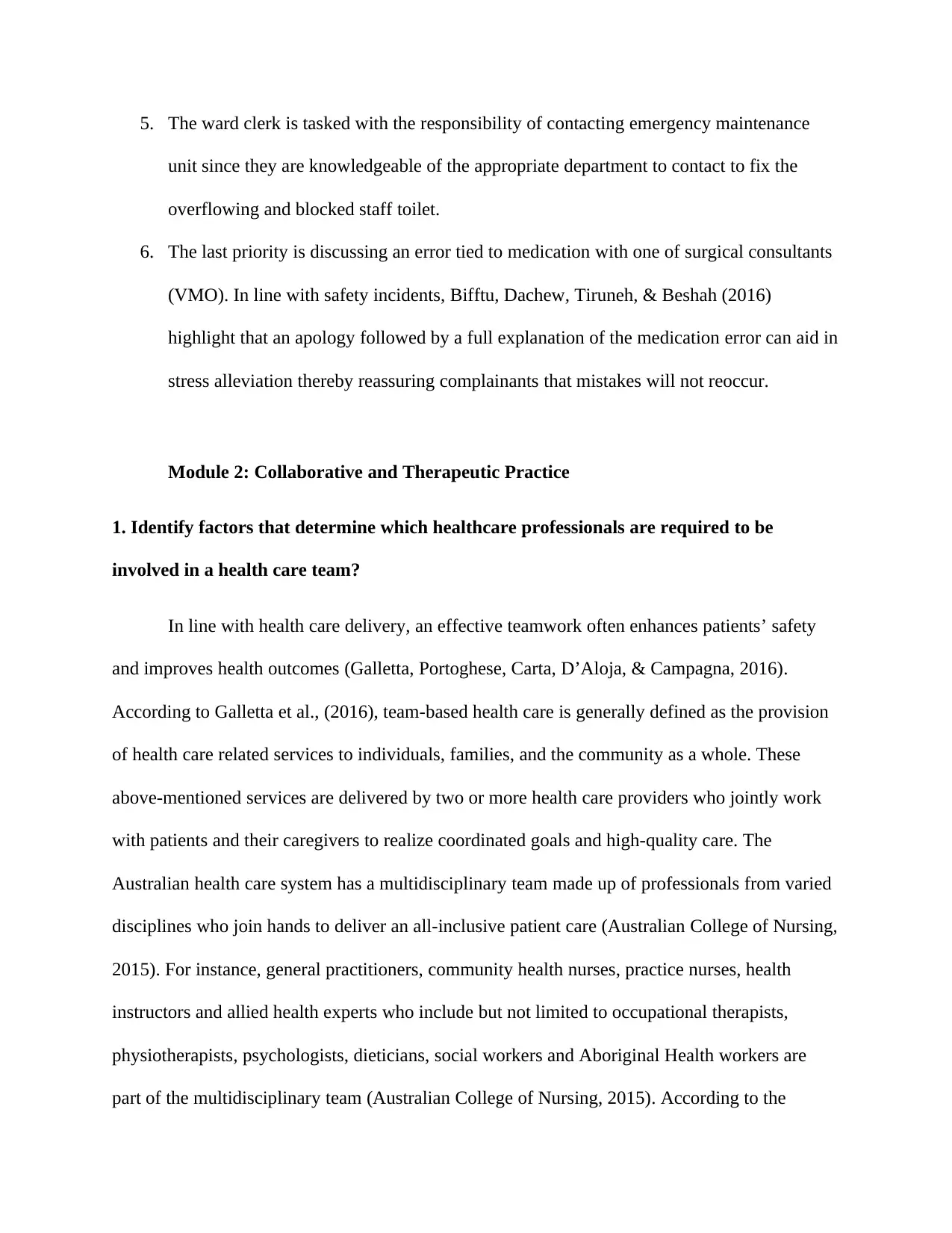
5. The ward clerk is tasked with the responsibility of contacting emergency maintenance
unit since they are knowledgeable of the appropriate department to contact to fix the
overflowing and blocked staff toilet.
6. The last priority is discussing an error tied to medication with one of surgical consultants
(VMO). In line with safety incidents, Bifftu, Dachew, Tiruneh, & Beshah (2016)
highlight that an apology followed by a full explanation of the medication error can aid in
stress alleviation thereby reassuring complainants that mistakes will not reoccur.
Module 2: Collaborative and Therapeutic Practice
1. Identify factors that determine which healthcare professionals are required to be
involved in a health care team?
In line with health care delivery, an effective teamwork often enhances patients’ safety
and improves health outcomes (Galletta, Portoghese, Carta, D’Aloja, & Campagna, 2016).
According to Galletta et al., (2016), team-based health care is generally defined as the provision
of health care related services to individuals, families, and the community as a whole. These
above-mentioned services are delivered by two or more health care providers who jointly work
with patients and their caregivers to realize coordinated goals and high-quality care. The
Australian health care system has a multidisciplinary team made up of professionals from varied
disciplines who join hands to deliver an all-inclusive patient care (Australian College of Nursing,
2015). For instance, general practitioners, community health nurses, practice nurses, health
instructors and allied health experts who include but not limited to occupational therapists,
physiotherapists, psychologists, dieticians, social workers and Aboriginal Health workers are
part of the multidisciplinary team (Australian College of Nursing, 2015). According to the
unit since they are knowledgeable of the appropriate department to contact to fix the
overflowing and blocked staff toilet.
6. The last priority is discussing an error tied to medication with one of surgical consultants
(VMO). In line with safety incidents, Bifftu, Dachew, Tiruneh, & Beshah (2016)
highlight that an apology followed by a full explanation of the medication error can aid in
stress alleviation thereby reassuring complainants that mistakes will not reoccur.
Module 2: Collaborative and Therapeutic Practice
1. Identify factors that determine which healthcare professionals are required to be
involved in a health care team?
In line with health care delivery, an effective teamwork often enhances patients’ safety
and improves health outcomes (Galletta, Portoghese, Carta, D’Aloja, & Campagna, 2016).
According to Galletta et al., (2016), team-based health care is generally defined as the provision
of health care related services to individuals, families, and the community as a whole. These
above-mentioned services are delivered by two or more health care providers who jointly work
with patients and their caregivers to realize coordinated goals and high-quality care. The
Australian health care system has a multidisciplinary team made up of professionals from varied
disciplines who join hands to deliver an all-inclusive patient care (Australian College of Nursing,
2015). For instance, general practitioners, community health nurses, practice nurses, health
instructors and allied health experts who include but not limited to occupational therapists,
physiotherapists, psychologists, dieticians, social workers and Aboriginal Health workers are
part of the multidisciplinary team (Australian College of Nursing, 2015). According to the
⊘ This is a preview!⊘
Do you want full access?
Subscribe today to unlock all pages.

Trusted by 1+ million students worldwide
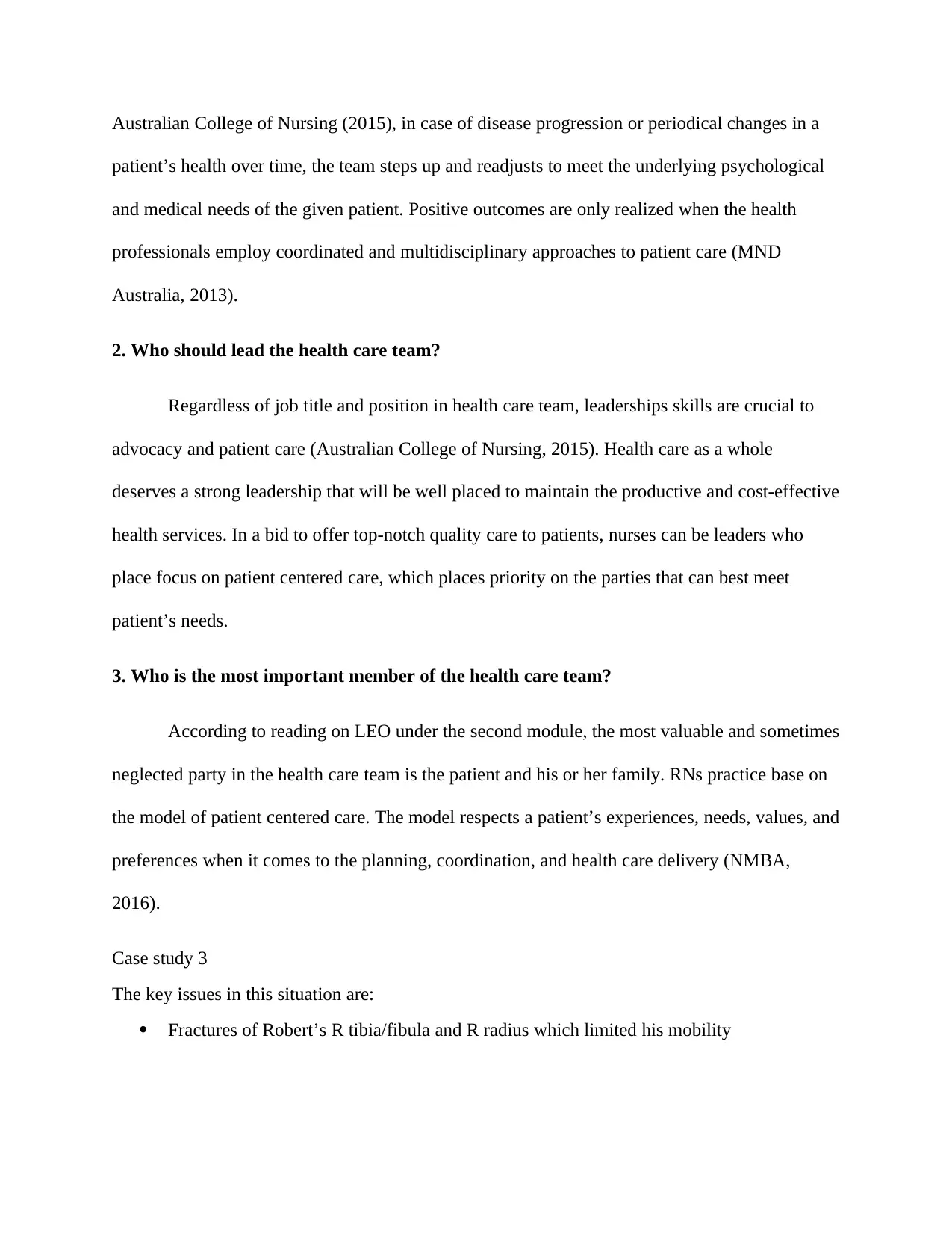
Australian College of Nursing (2015), in case of disease progression or periodical changes in a
patient’s health over time, the team steps up and readjusts to meet the underlying psychological
and medical needs of the given patient. Positive outcomes are only realized when the health
professionals employ coordinated and multidisciplinary approaches to patient care (MND
Australia, 2013).
2. Who should lead the health care team?
Regardless of job title and position in health care team, leaderships skills are crucial to
advocacy and patient care (Australian College of Nursing, 2015). Health care as a whole
deserves a strong leadership that will be well placed to maintain the productive and cost-effective
health services. In a bid to offer top-notch quality care to patients, nurses can be leaders who
place focus on patient centered care, which places priority on the parties that can best meet
patient’s needs.
3. Who is the most important member of the health care team?
According to reading on LEO under the second module, the most valuable and sometimes
neglected party in the health care team is the patient and his or her family. RNs practice base on
the model of patient centered care. The model respects a patient’s experiences, needs, values, and
preferences when it comes to the planning, coordination, and health care delivery (NMBA,
2016).
Case study 3
The key issues in this situation are:
Fractures of Robert’s R tibia/fibula and R radius which limited his mobility
patient’s health over time, the team steps up and readjusts to meet the underlying psychological
and medical needs of the given patient. Positive outcomes are only realized when the health
professionals employ coordinated and multidisciplinary approaches to patient care (MND
Australia, 2013).
2. Who should lead the health care team?
Regardless of job title and position in health care team, leaderships skills are crucial to
advocacy and patient care (Australian College of Nursing, 2015). Health care as a whole
deserves a strong leadership that will be well placed to maintain the productive and cost-effective
health services. In a bid to offer top-notch quality care to patients, nurses can be leaders who
place focus on patient centered care, which places priority on the parties that can best meet
patient’s needs.
3. Who is the most important member of the health care team?
According to reading on LEO under the second module, the most valuable and sometimes
neglected party in the health care team is the patient and his or her family. RNs practice base on
the model of patient centered care. The model respects a patient’s experiences, needs, values, and
preferences when it comes to the planning, coordination, and health care delivery (NMBA,
2016).
Case study 3
The key issues in this situation are:
Fractures of Robert’s R tibia/fibula and R radius which limited his mobility
Paraphrase This Document
Need a fresh take? Get an instant paraphrase of this document with our AI Paraphraser
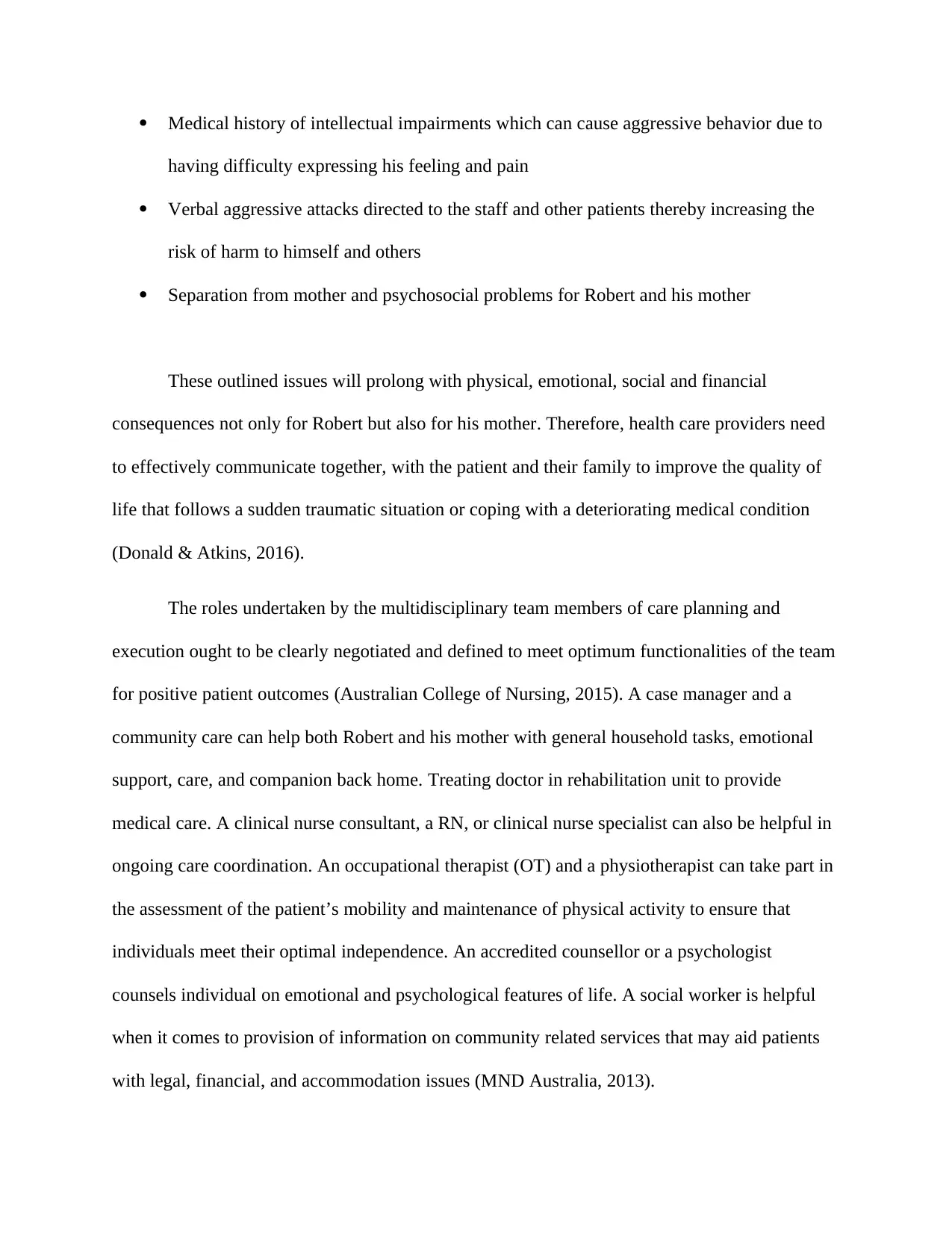
Medical history of intellectual impairments which can cause aggressive behavior due to
having difficulty expressing his feeling and pain
Verbal aggressive attacks directed to the staff and other patients thereby increasing the
risk of harm to himself and others
Separation from mother and psychosocial problems for Robert and his mother
These outlined issues will prolong with physical, emotional, social and financial
consequences not only for Robert but also for his mother. Therefore, health care providers need
to effectively communicate together, with the patient and their family to improve the quality of
life that follows a sudden traumatic situation or coping with a deteriorating medical condition
(Donald & Atkins, 2016).
The roles undertaken by the multidisciplinary team members of care planning and
execution ought to be clearly negotiated and defined to meet optimum functionalities of the team
for positive patient outcomes (Australian College of Nursing, 2015). A case manager and a
community care can help both Robert and his mother with general household tasks, emotional
support, care, and companion back home. Treating doctor in rehabilitation unit to provide
medical care. A clinical nurse consultant, a RN, or clinical nurse specialist can also be helpful in
ongoing care coordination. An occupational therapist (OT) and a physiotherapist can take part in
the assessment of the patient’s mobility and maintenance of physical activity to ensure that
individuals meet their optimal independence. An accredited counsellor or a psychologist
counsels individual on emotional and psychological features of life. A social worker is helpful
when it comes to provision of information on community related services that may aid patients
with legal, financial, and accommodation issues (MND Australia, 2013).
having difficulty expressing his feeling and pain
Verbal aggressive attacks directed to the staff and other patients thereby increasing the
risk of harm to himself and others
Separation from mother and psychosocial problems for Robert and his mother
These outlined issues will prolong with physical, emotional, social and financial
consequences not only for Robert but also for his mother. Therefore, health care providers need
to effectively communicate together, with the patient and their family to improve the quality of
life that follows a sudden traumatic situation or coping with a deteriorating medical condition
(Donald & Atkins, 2016).
The roles undertaken by the multidisciplinary team members of care planning and
execution ought to be clearly negotiated and defined to meet optimum functionalities of the team
for positive patient outcomes (Australian College of Nursing, 2015). A case manager and a
community care can help both Robert and his mother with general household tasks, emotional
support, care, and companion back home. Treating doctor in rehabilitation unit to provide
medical care. A clinical nurse consultant, a RN, or clinical nurse specialist can also be helpful in
ongoing care coordination. An occupational therapist (OT) and a physiotherapist can take part in
the assessment of the patient’s mobility and maintenance of physical activity to ensure that
individuals meet their optimal independence. An accredited counsellor or a psychologist
counsels individual on emotional and psychological features of life. A social worker is helpful
when it comes to provision of information on community related services that may aid patients
with legal, financial, and accommodation issues (MND Australia, 2013).
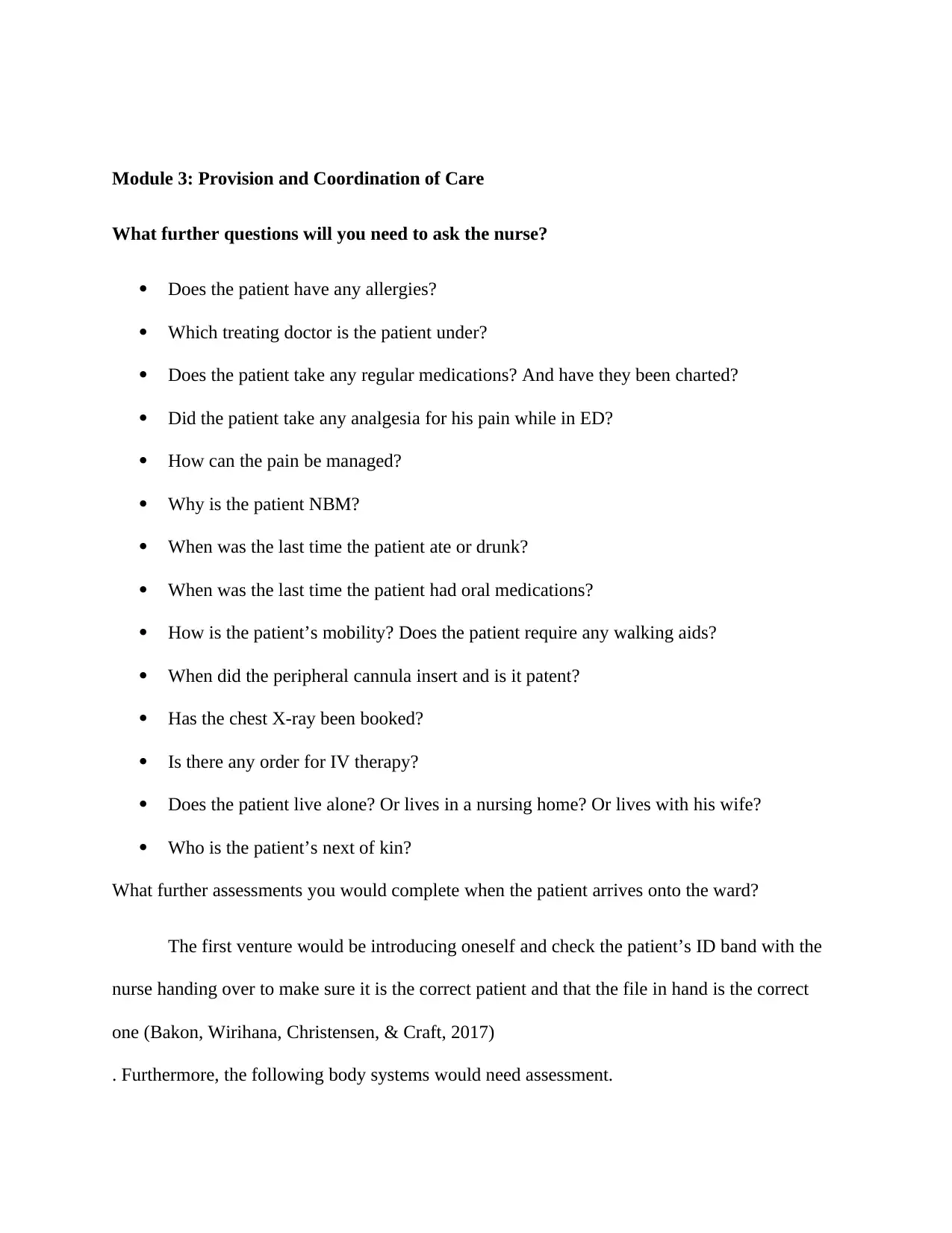
Module 3: Provision and Coordination of Care
What further questions will you need to ask the nurse?
Does the patient have any allergies?
Which treating doctor is the patient under?
Does the patient take any regular medications? And have they been charted?
Did the patient take any analgesia for his pain while in ED?
How can the pain be managed?
Why is the patient NBM?
When was the last time the patient ate or drunk?
When was the last time the patient had oral medications?
How is the patient’s mobility? Does the patient require any walking aids?
When did the peripheral cannula insert and is it patent?
Has the chest X-ray been booked?
Is there any order for IV therapy?
Does the patient live alone? Or lives in a nursing home? Or lives with his wife?
Who is the patient’s next of kin?
What further assessments you would complete when the patient arrives onto the ward?
The first venture would be introducing oneself and check the patient’s ID band with the
nurse handing over to make sure it is the correct patient and that the file in hand is the correct
one (Bakon, Wirihana, Christensen, & Craft, 2017)
. Furthermore, the following body systems would need assessment.
What further questions will you need to ask the nurse?
Does the patient have any allergies?
Which treating doctor is the patient under?
Does the patient take any regular medications? And have they been charted?
Did the patient take any analgesia for his pain while in ED?
How can the pain be managed?
Why is the patient NBM?
When was the last time the patient ate or drunk?
When was the last time the patient had oral medications?
How is the patient’s mobility? Does the patient require any walking aids?
When did the peripheral cannula insert and is it patent?
Has the chest X-ray been booked?
Is there any order for IV therapy?
Does the patient live alone? Or lives in a nursing home? Or lives with his wife?
Who is the patient’s next of kin?
What further assessments you would complete when the patient arrives onto the ward?
The first venture would be introducing oneself and check the patient’s ID band with the
nurse handing over to make sure it is the correct patient and that the file in hand is the correct
one (Bakon, Wirihana, Christensen, & Craft, 2017)
. Furthermore, the following body systems would need assessment.
⊘ This is a preview!⊘
Do you want full access?
Subscribe today to unlock all pages.

Trusted by 1+ million students worldwide
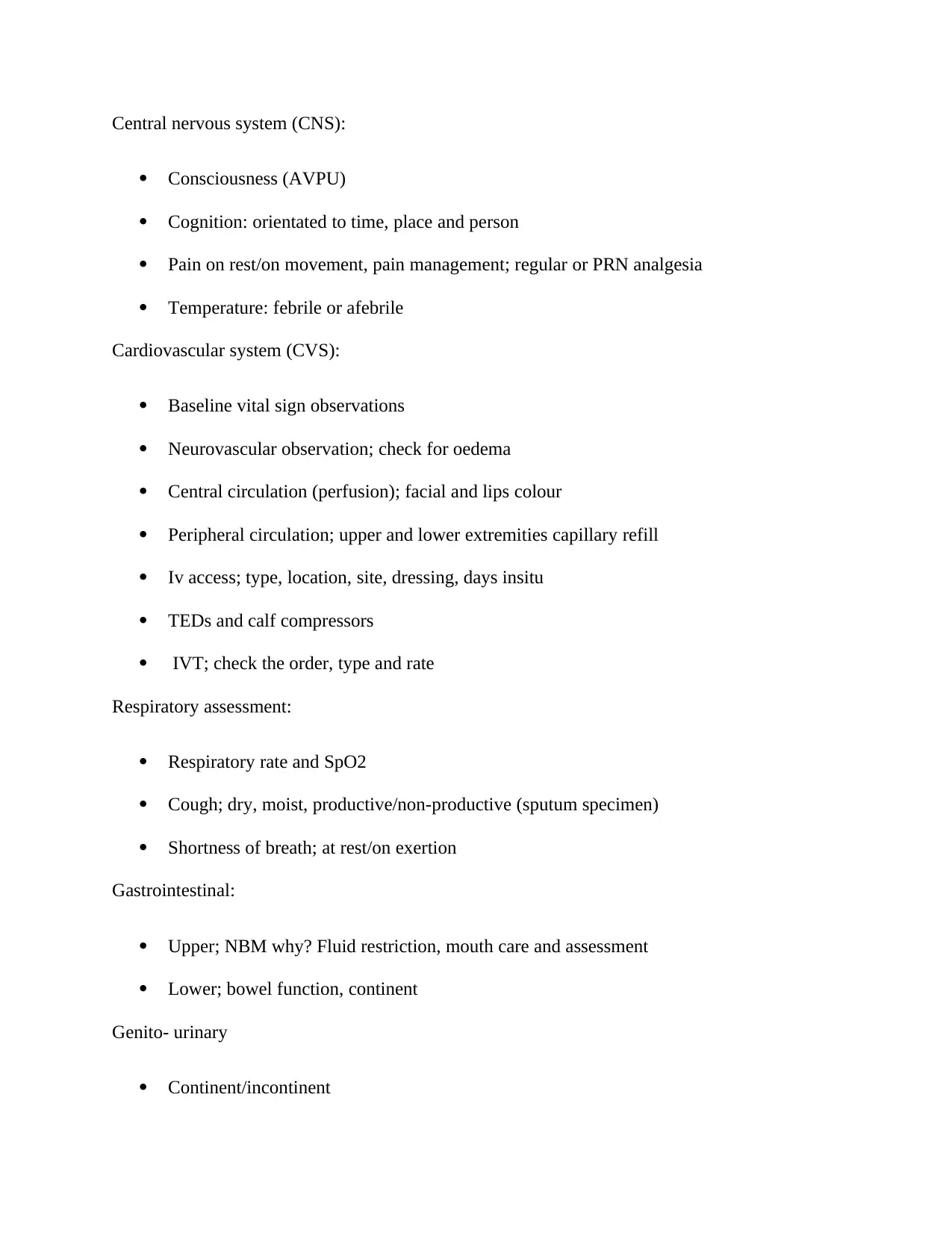
Central nervous system (CNS):
Consciousness (AVPU)
Cognition: orientated to time, place and person
Pain on rest/on movement, pain management; regular or PRN analgesia
Temperature: febrile or afebrile
Cardiovascular system (CVS):
Baseline vital sign observations
Neurovascular observation; check for oedema
Central circulation (perfusion); facial and lips colour
Peripheral circulation; upper and lower extremities capillary refill
Iv access; type, location, site, dressing, days insitu
TEDs and calf compressors
IVT; check the order, type and rate
Respiratory assessment:
Respiratory rate and SpO2
Cough; dry, moist, productive/non-productive (sputum specimen)
Shortness of breath; at rest/on exertion
Gastrointestinal:
Upper; NBM why? Fluid restriction, mouth care and assessment
Lower; bowel function, continent
Genito- urinary
Continent/incontinent
Consciousness (AVPU)
Cognition: orientated to time, place and person
Pain on rest/on movement, pain management; regular or PRN analgesia
Temperature: febrile or afebrile
Cardiovascular system (CVS):
Baseline vital sign observations
Neurovascular observation; check for oedema
Central circulation (perfusion); facial and lips colour
Peripheral circulation; upper and lower extremities capillary refill
Iv access; type, location, site, dressing, days insitu
TEDs and calf compressors
IVT; check the order, type and rate
Respiratory assessment:
Respiratory rate and SpO2
Cough; dry, moist, productive/non-productive (sputum specimen)
Shortness of breath; at rest/on exertion
Gastrointestinal:
Upper; NBM why? Fluid restriction, mouth care and assessment
Lower; bowel function, continent
Genito- urinary
Continent/incontinent
Paraphrase This Document
Need a fresh take? Get an instant paraphrase of this document with our AI Paraphraser
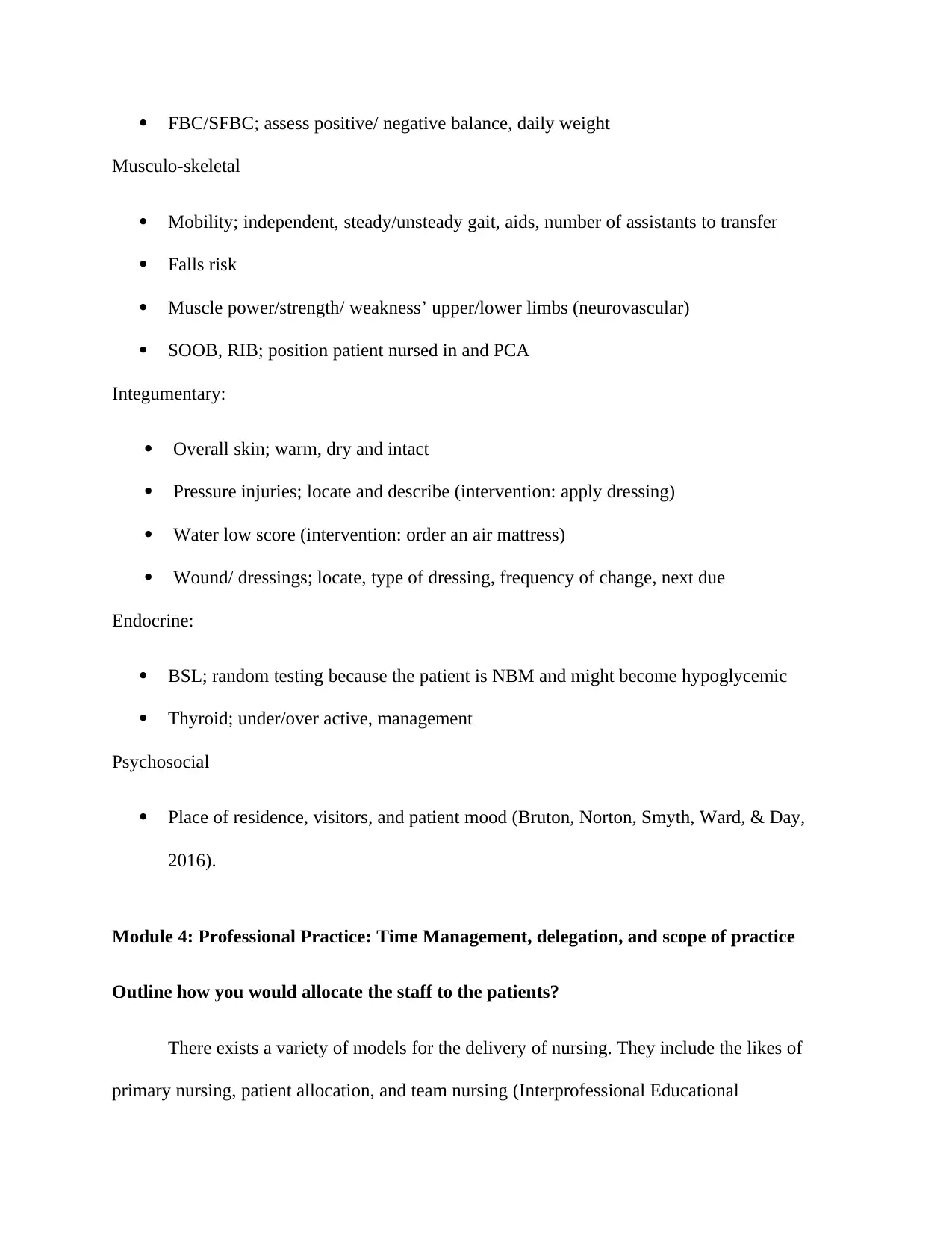
FBC/SFBC; assess positive/ negative balance, daily weight
Musculo-skeletal
Mobility; independent, steady/unsteady gait, aids, number of assistants to transfer
Falls risk
Muscle power/strength/ weakness’ upper/lower limbs (neurovascular)
SOOB, RIB; position patient nursed in and PCA
Integumentary:
Overall skin; warm, dry and intact
Pressure injuries; locate and describe (intervention: apply dressing)
Water low score (intervention: order an air mattress)
Wound/ dressings; locate, type of dressing, frequency of change, next due
Endocrine:
BSL; random testing because the patient is NBM and might become hypoglycemic
Thyroid; under/over active, management
Psychosocial
Place of residence, visitors, and patient mood (Bruton, Norton, Smyth, Ward, & Day,
2016).
Module 4: Professional Practice: Time Management, delegation, and scope of practice
Outline how you would allocate the staff to the patients?
There exists a variety of models for the delivery of nursing. They include the likes of
primary nursing, patient allocation, and team nursing (Interprofessional Educational
Musculo-skeletal
Mobility; independent, steady/unsteady gait, aids, number of assistants to transfer
Falls risk
Muscle power/strength/ weakness’ upper/lower limbs (neurovascular)
SOOB, RIB; position patient nursed in and PCA
Integumentary:
Overall skin; warm, dry and intact
Pressure injuries; locate and describe (intervention: apply dressing)
Water low score (intervention: order an air mattress)
Wound/ dressings; locate, type of dressing, frequency of change, next due
Endocrine:
BSL; random testing because the patient is NBM and might become hypoglycemic
Thyroid; under/over active, management
Psychosocial
Place of residence, visitors, and patient mood (Bruton, Norton, Smyth, Ward, & Day,
2016).
Module 4: Professional Practice: Time Management, delegation, and scope of practice
Outline how you would allocate the staff to the patients?
There exists a variety of models for the delivery of nursing. They include the likes of
primary nursing, patient allocation, and team nursing (Interprofessional Educational
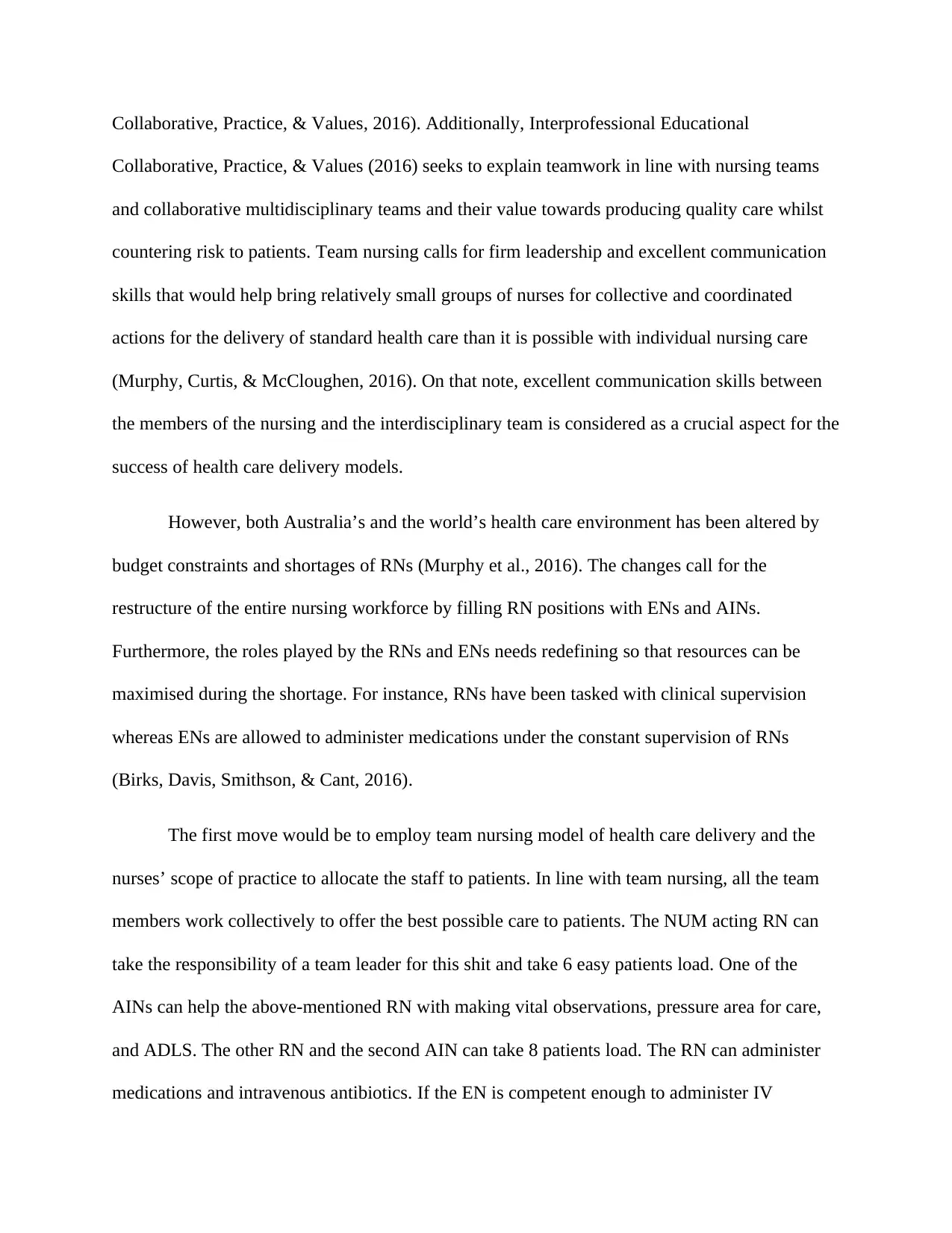
Collaborative, Practice, & Values, 2016). Additionally, Interprofessional Educational
Collaborative, Practice, & Values (2016) seeks to explain teamwork in line with nursing teams
and collaborative multidisciplinary teams and their value towards producing quality care whilst
countering risk to patients. Team nursing calls for firm leadership and excellent communication
skills that would help bring relatively small groups of nurses for collective and coordinated
actions for the delivery of standard health care than it is possible with individual nursing care
(Murphy, Curtis, & McCloughen, 2016). On that note, excellent communication skills between
the members of the nursing and the interdisciplinary team is considered as a crucial aspect for the
success of health care delivery models.
However, both Australia’s and the world’s health care environment has been altered by
budget constraints and shortages of RNs (Murphy et al., 2016). The changes call for the
restructure of the entire nursing workforce by filling RN positions with ENs and AINs.
Furthermore, the roles played by the RNs and ENs needs redefining so that resources can be
maximised during the shortage. For instance, RNs have been tasked with clinical supervision
whereas ENs are allowed to administer medications under the constant supervision of RNs
(Birks, Davis, Smithson, & Cant, 2016).
The first move would be to employ team nursing model of health care delivery and the
nurses’ scope of practice to allocate the staff to patients. In line with team nursing, all the team
members work collectively to offer the best possible care to patients. The NUM acting RN can
take the responsibility of a team leader for this shit and take 6 easy patients load. One of the
AINs can help the above-mentioned RN with making vital observations, pressure area for care,
and ADLS. The other RN and the second AIN can take 8 patients load. The RN can administer
medications and intravenous antibiotics. If the EN is competent enough to administer IV
Collaborative, Practice, & Values (2016) seeks to explain teamwork in line with nursing teams
and collaborative multidisciplinary teams and their value towards producing quality care whilst
countering risk to patients. Team nursing calls for firm leadership and excellent communication
skills that would help bring relatively small groups of nurses for collective and coordinated
actions for the delivery of standard health care than it is possible with individual nursing care
(Murphy, Curtis, & McCloughen, 2016). On that note, excellent communication skills between
the members of the nursing and the interdisciplinary team is considered as a crucial aspect for the
success of health care delivery models.
However, both Australia’s and the world’s health care environment has been altered by
budget constraints and shortages of RNs (Murphy et al., 2016). The changes call for the
restructure of the entire nursing workforce by filling RN positions with ENs and AINs.
Furthermore, the roles played by the RNs and ENs needs redefining so that resources can be
maximised during the shortage. For instance, RNs have been tasked with clinical supervision
whereas ENs are allowed to administer medications under the constant supervision of RNs
(Birks, Davis, Smithson, & Cant, 2016).
The first move would be to employ team nursing model of health care delivery and the
nurses’ scope of practice to allocate the staff to patients. In line with team nursing, all the team
members work collectively to offer the best possible care to patients. The NUM acting RN can
take the responsibility of a team leader for this shit and take 6 easy patients load. One of the
AINs can help the above-mentioned RN with making vital observations, pressure area for care,
and ADLS. The other RN and the second AIN can take 8 patients load. The RN can administer
medications and intravenous antibiotics. If the EN is competent enough to administer IV
⊘ This is a preview!⊘
Do you want full access?
Subscribe today to unlock all pages.

Trusted by 1+ million students worldwide
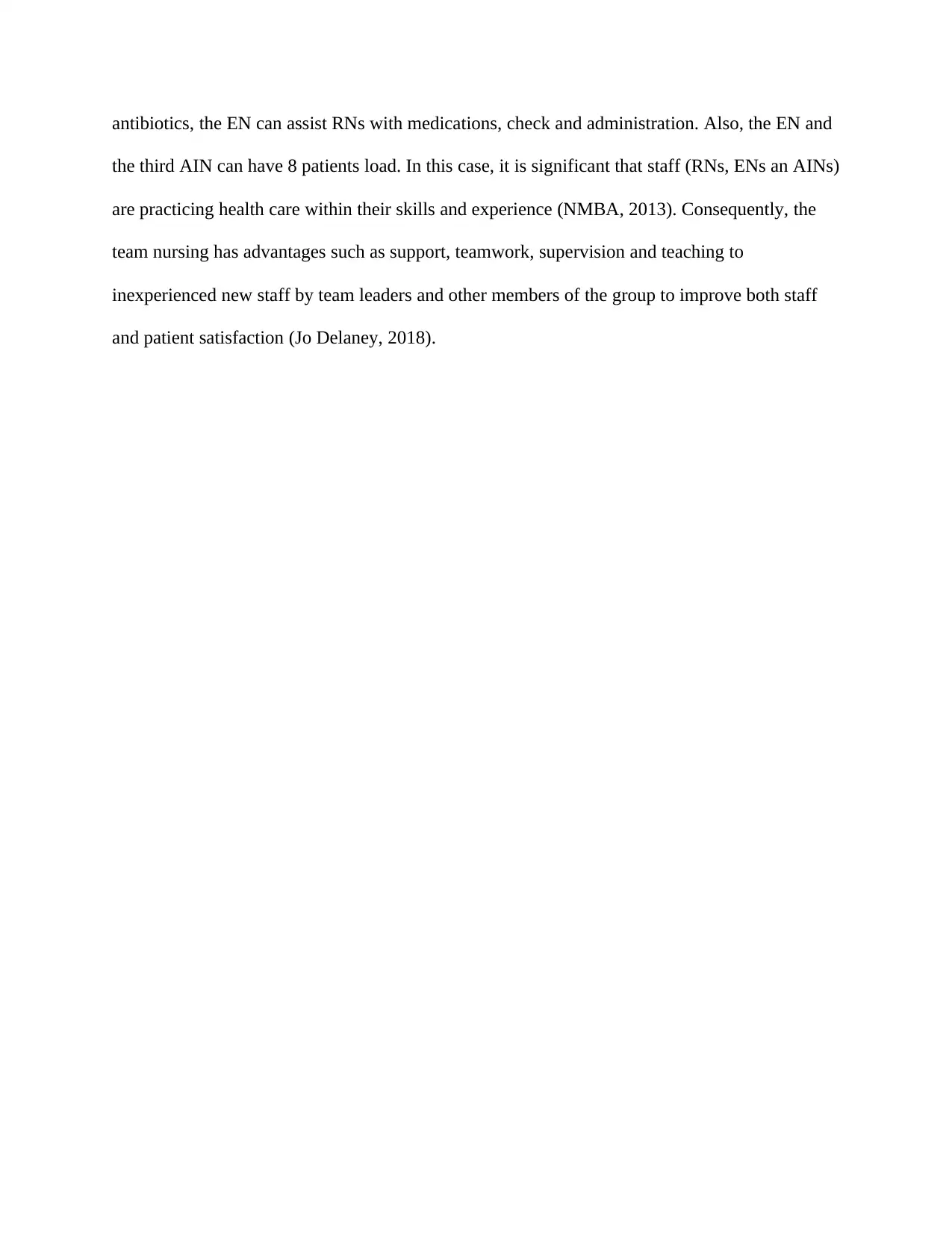
antibiotics, the EN can assist RNs with medications, check and administration. Also, the EN and
the third AIN can have 8 patients load. In this case, it is significant that staff (RNs, ENs an AINs)
are practicing health care within their skills and experience (NMBA, 2013). Consequently, the
team nursing has advantages such as support, teamwork, supervision and teaching to
inexperienced new staff by team leaders and other members of the group to improve both staff
and patient satisfaction (Jo Delaney, 2018).
the third AIN can have 8 patients load. In this case, it is significant that staff (RNs, ENs an AINs)
are practicing health care within their skills and experience (NMBA, 2013). Consequently, the
team nursing has advantages such as support, teamwork, supervision and teaching to
inexperienced new staff by team leaders and other members of the group to improve both staff
and patient satisfaction (Jo Delaney, 2018).
Paraphrase This Document
Need a fresh take? Get an instant paraphrase of this document with our AI Paraphraser
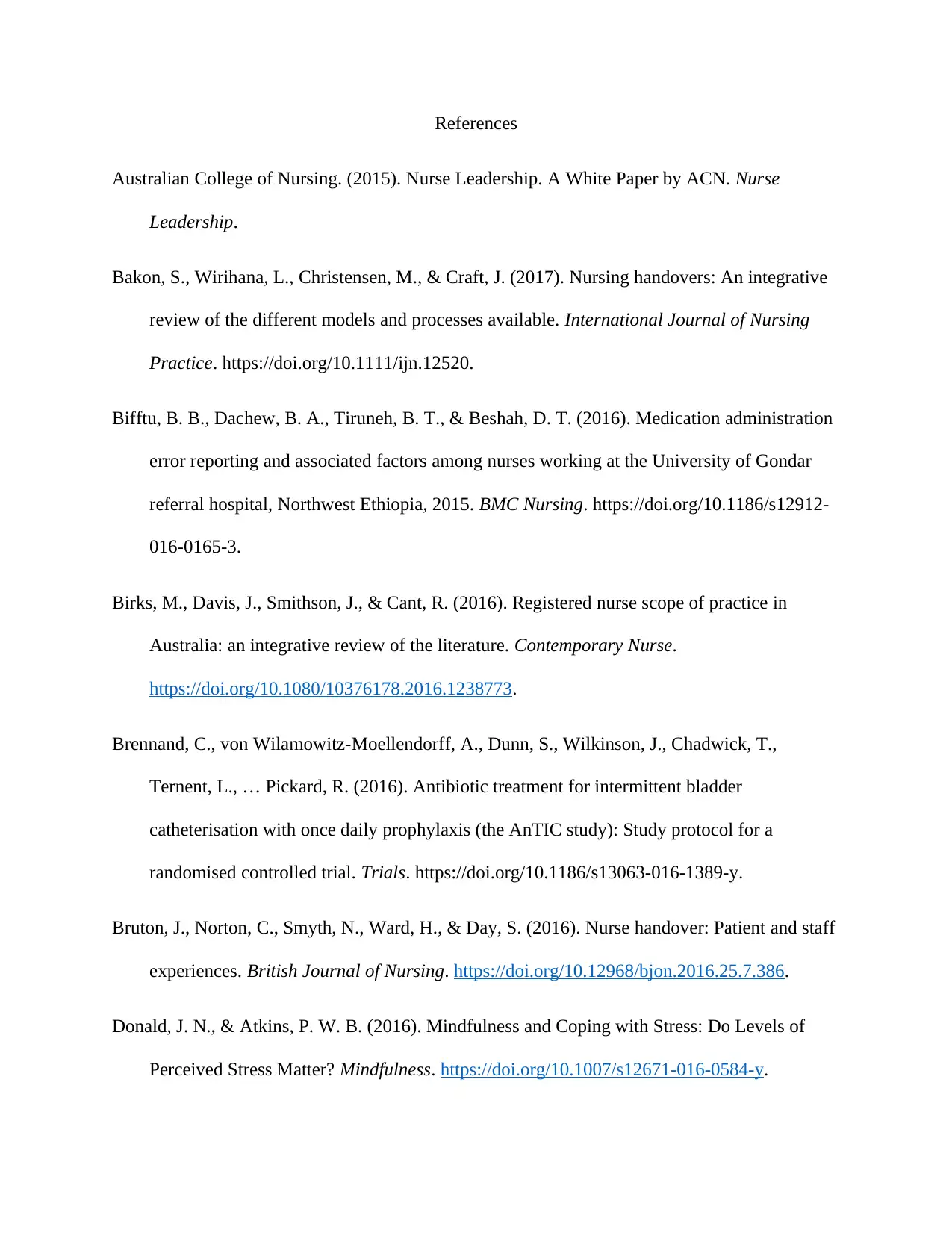
References
Australian College of Nursing. (2015). Nurse Leadership. A White Paper by ACN. Nurse
Leadership.
Bakon, S., Wirihana, L., Christensen, M., & Craft, J. (2017). Nursing handovers: An integrative
review of the different models and processes available. International Journal of Nursing
Practice. https://doi.org/10.1111/ijn.12520.
Bifftu, B. B., Dachew, B. A., Tiruneh, B. T., & Beshah, D. T. (2016). Medication administration
error reporting and associated factors among nurses working at the University of Gondar
referral hospital, Northwest Ethiopia, 2015. BMC Nursing. https://doi.org/10.1186/s12912-
016-0165-3.
Birks, M., Davis, J., Smithson, J., & Cant, R. (2016). Registered nurse scope of practice in
Australia: an integrative review of the literature. Contemporary Nurse.
https://doi.org/10.1080/10376178.2016.1238773.
Brennand, C., von Wilamowitz-Moellendorff, A., Dunn, S., Wilkinson, J., Chadwick, T.,
Ternent, L., … Pickard, R. (2016). Antibiotic treatment for intermittent bladder
catheterisation with once daily prophylaxis (the AnTIC study): Study protocol for a
randomised controlled trial. Trials. https://doi.org/10.1186/s13063-016-1389-y.
Bruton, J., Norton, C., Smyth, N., Ward, H., & Day, S. (2016). Nurse handover: Patient and staff
experiences. British Journal of Nursing. https://doi.org/10.12968/bjon.2016.25.7.386.
Donald, J. N., & Atkins, P. W. B. (2016). Mindfulness and Coping with Stress: Do Levels of
Perceived Stress Matter? Mindfulness. https://doi.org/10.1007/s12671-016-0584-y.
Australian College of Nursing. (2015). Nurse Leadership. A White Paper by ACN. Nurse
Leadership.
Bakon, S., Wirihana, L., Christensen, M., & Craft, J. (2017). Nursing handovers: An integrative
review of the different models and processes available. International Journal of Nursing
Practice. https://doi.org/10.1111/ijn.12520.
Bifftu, B. B., Dachew, B. A., Tiruneh, B. T., & Beshah, D. T. (2016). Medication administration
error reporting and associated factors among nurses working at the University of Gondar
referral hospital, Northwest Ethiopia, 2015. BMC Nursing. https://doi.org/10.1186/s12912-
016-0165-3.
Birks, M., Davis, J., Smithson, J., & Cant, R. (2016). Registered nurse scope of practice in
Australia: an integrative review of the literature. Contemporary Nurse.
https://doi.org/10.1080/10376178.2016.1238773.
Brennand, C., von Wilamowitz-Moellendorff, A., Dunn, S., Wilkinson, J., Chadwick, T.,
Ternent, L., … Pickard, R. (2016). Antibiotic treatment for intermittent bladder
catheterisation with once daily prophylaxis (the AnTIC study): Study protocol for a
randomised controlled trial. Trials. https://doi.org/10.1186/s13063-016-1389-y.
Bruton, J., Norton, C., Smyth, N., Ward, H., & Day, S. (2016). Nurse handover: Patient and staff
experiences. British Journal of Nursing. https://doi.org/10.12968/bjon.2016.25.7.386.
Donald, J. N., & Atkins, P. W. B. (2016). Mindfulness and Coping with Stress: Do Levels of
Perceived Stress Matter? Mindfulness. https://doi.org/10.1007/s12671-016-0584-y.
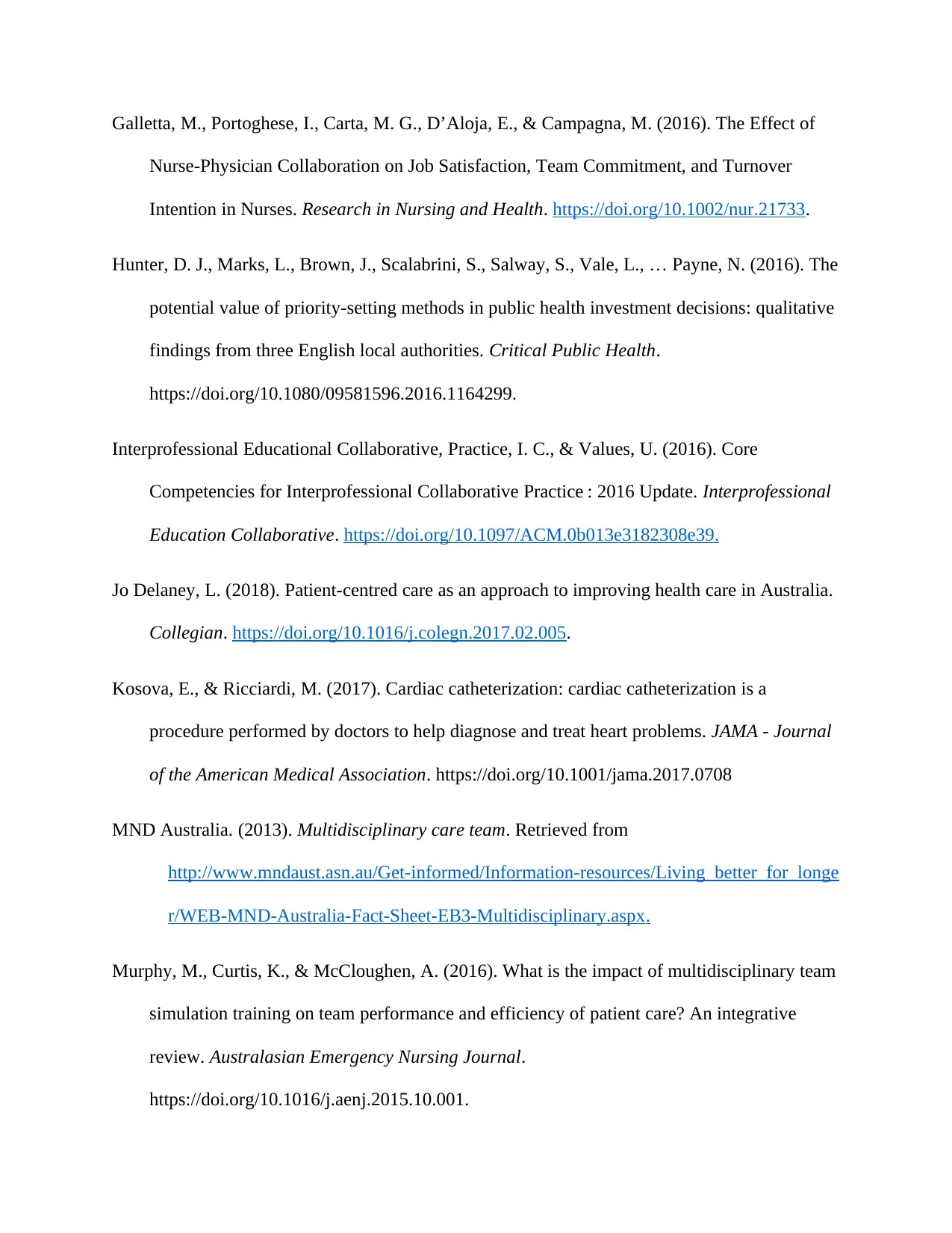
Galletta, M., Portoghese, I., Carta, M. G., D’Aloja, E., & Campagna, M. (2016). The Effect of
Nurse-Physician Collaboration on Job Satisfaction, Team Commitment, and Turnover
Intention in Nurses. Research in Nursing and Health. https://doi.org/10.1002/nur.21733.
Hunter, D. J., Marks, L., Brown, J., Scalabrini, S., Salway, S., Vale, L., … Payne, N. (2016). The
potential value of priority-setting methods in public health investment decisions: qualitative
findings from three English local authorities. Critical Public Health.
https://doi.org/10.1080/09581596.2016.1164299.
Interprofessional Educational Collaborative, Practice, I. C., & Values, U. (2016). Core
Competencies for Interprofessional Collaborative Practice : 2016 Update. Interprofessional
Education Collaborative. https://doi.org/10.1097/ACM.0b013e3182308e39.
Jo Delaney, L. (2018). Patient-centred care as an approach to improving health care in Australia.
Collegian. https://doi.org/10.1016/j.colegn.2017.02.005.
Kosova, E., & Ricciardi, M. (2017). Cardiac catheterization: cardiac catheterization is a
procedure performed by doctors to help diagnose and treat heart problems. JAMA - Journal
of the American Medical Association. https://doi.org/10.1001/jama.2017.0708
MND Australia. (2013). Multidisciplinary care team. Retrieved from
http://www.mndaust.asn.au/Get-informed/Information-resources/Living_better_for_longe
r/WEB-MND-Australia-Fact-Sheet-EB3-Multidisciplinary.aspx.
Murphy, M., Curtis, K., & McCloughen, A. (2016). What is the impact of multidisciplinary team
simulation training on team performance and efficiency of patient care? An integrative
review. Australasian Emergency Nursing Journal.
https://doi.org/10.1016/j.aenj.2015.10.001.
Nurse-Physician Collaboration on Job Satisfaction, Team Commitment, and Turnover
Intention in Nurses. Research in Nursing and Health. https://doi.org/10.1002/nur.21733.
Hunter, D. J., Marks, L., Brown, J., Scalabrini, S., Salway, S., Vale, L., … Payne, N. (2016). The
potential value of priority-setting methods in public health investment decisions: qualitative
findings from three English local authorities. Critical Public Health.
https://doi.org/10.1080/09581596.2016.1164299.
Interprofessional Educational Collaborative, Practice, I. C., & Values, U. (2016). Core
Competencies for Interprofessional Collaborative Practice : 2016 Update. Interprofessional
Education Collaborative. https://doi.org/10.1097/ACM.0b013e3182308e39.
Jo Delaney, L. (2018). Patient-centred care as an approach to improving health care in Australia.
Collegian. https://doi.org/10.1016/j.colegn.2017.02.005.
Kosova, E., & Ricciardi, M. (2017). Cardiac catheterization: cardiac catheterization is a
procedure performed by doctors to help diagnose and treat heart problems. JAMA - Journal
of the American Medical Association. https://doi.org/10.1001/jama.2017.0708
MND Australia. (2013). Multidisciplinary care team. Retrieved from
http://www.mndaust.asn.au/Get-informed/Information-resources/Living_better_for_longe
r/WEB-MND-Australia-Fact-Sheet-EB3-Multidisciplinary.aspx.
Murphy, M., Curtis, K., & McCloughen, A. (2016). What is the impact of multidisciplinary team
simulation training on team performance and efficiency of patient care? An integrative
review. Australasian Emergency Nursing Journal.
https://doi.org/10.1016/j.aenj.2015.10.001.
⊘ This is a preview!⊘
Do you want full access?
Subscribe today to unlock all pages.

Trusted by 1+ million students worldwide
1 out of 13
Related Documents
Your All-in-One AI-Powered Toolkit for Academic Success.
+13062052269
info@desklib.com
Available 24*7 on WhatsApp / Email
![[object Object]](/_next/static/media/star-bottom.7253800d.svg)
Unlock your academic potential
Copyright © 2020–2025 A2Z Services. All Rights Reserved. Developed and managed by ZUCOL.





